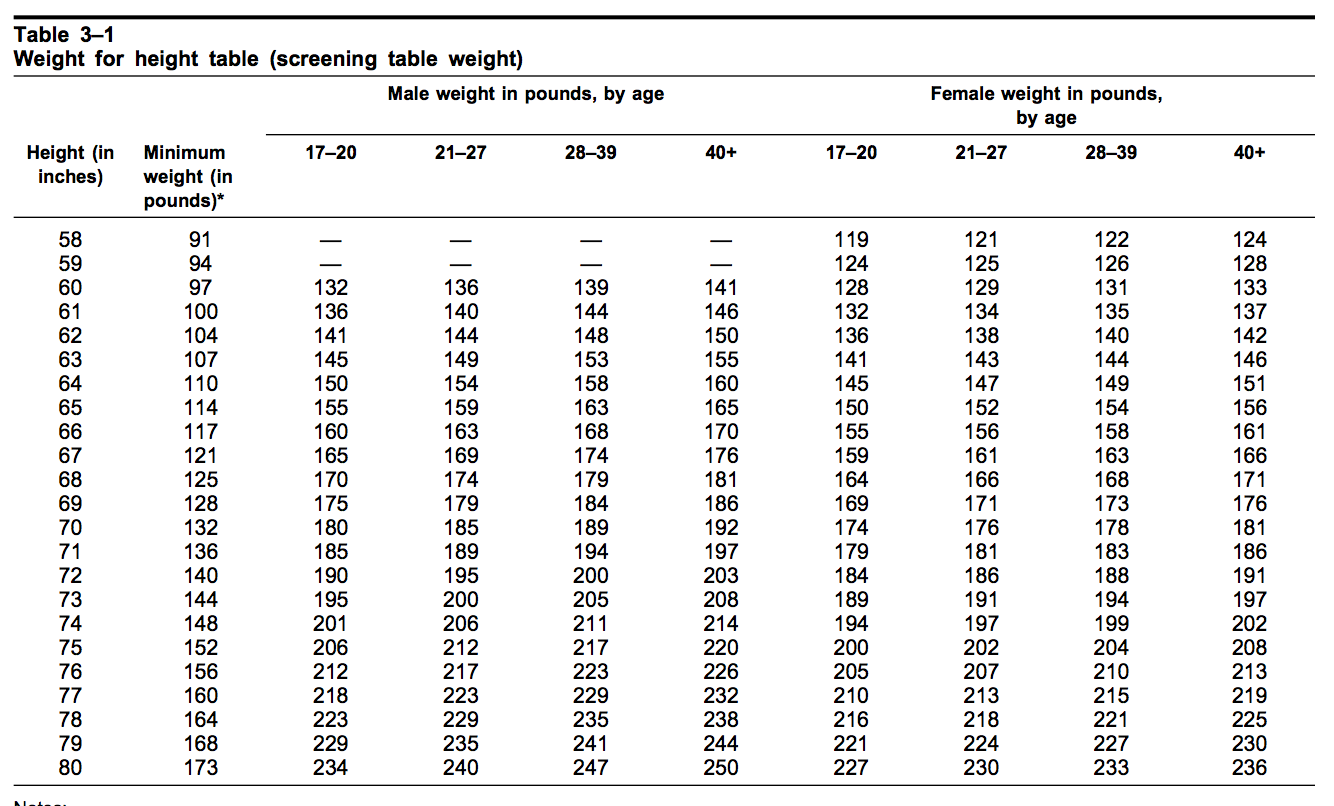The Army height and weight chart serves as a crucial standard for service members, ensuring they meet the physical requirements necessary for military readiness. Maintaining an appropriate weight and height ratio is essential for operational effectiveness, as the military emphasizes physical fitness as a component of overall health. The chart provides clear guidelines that help personnel understand where they stand in relation to these standards, allowing for better preparation and adjustment if necessary.
Each branch of the military has its specific height and weight criteria, which are influenced by various factors, including age and gender. These standards are not arbitrary; they have been developed through years of research into optimal body composition for performance in various roles within the armed forces. Understanding the Army height and weight chart can help aspiring recruits, current soldiers, and their families navigate the often complex requirements of military service.
In this article, we will dive deep into the specifics of the Army height and weight chart, exploring what it entails, why it matters, and how individuals can ensure they meet these important benchmarks. Whether you're a prospective recruit or simply curious about military standards, this comprehensive guide will provide the information you need to understand the significance of the Army height and weight chart.
What Is the Army Height and Weight Chart?
The Army height and weight chart is a set of standards that outlines the acceptable height and weight ranges for soldiers. These standards are designed to ensure that all personnel maintain a level of fitness necessary for the demands of military service. The chart varies by age and gender, reflecting the different physical characteristics found in these groups.
Why Is the Army Height and Weight Chart Important?
Maintaining a healthy weight is not just about appearance; it's about functionality and operational readiness. The Army height and weight chart plays a crucial role in ensuring that soldiers are physically capable of performing their duties. This aspect of military life helps to foster discipline, resilience, and overall well-being among service members.
How Is the Army Height and Weight Chart Utilized?
The Army uses the height and weight chart during enlistment and periodic evaluations. Soldiers are measured and weighed, and their results are compared against the standards set forth in the chart. Those who do not meet the requirements may be subject to corrective measures, including physical training or, in some cases, discharge from service.
What Are the Specific Standards in the Army Height and Weight Chart?
The Army height and weight chart is divided into different categories based on age and gender. These categories help to provide a more tailored approach to measuring fitness. Below is a brief overview of the typical standards:
- For males aged 17-20: Height range of 60 to 80 inches, with corresponding weight limits.
- For females aged 17-20: Height range of 58 to 78 inches, with corresponding weight limits.
- Standards adjust slightly for older age groups, reflecting natural changes in body composition.
How Do I Measure My Height and Weight Accurately?
To accurately measure your height and weight for the Army chart, follow these steps:
- Use a stadiometer for height measurement—stand straight with your heels together and look straight ahead.
- Weigh yourself on a calibrated scale—do this in the morning for consistency, wearing minimal clothing.
- Record the measurements and compare them against the Army height and weight chart for your age and gender.
What Happens If I Don’t Meet the Army Height and Weight Standards?
If a soldier fails to meet the Army height and weight standards, they may face several consequences:
- Mandatory enrollment in the Army Body Composition Program (ABCP).
- Increased physical training requirements.
- Potential promotion delays or disciplinary action.
Is There a Body Fat Percentage Requirement in Addition to the Army Height and Weight Chart?
Yes, the Army has additional body fat percentage requirements that complement the height and weight chart. Soldiers who meet the height and weight standards may still be evaluated based on body fat measurements, ensuring that they maintain a healthy composition.
How Can Soldiers Improve Their Fitness to Meet the Army Standards?
Improving fitness requires a combination of proper nutrition, regular exercise, and dedication. Here are some tips for soldiers looking to meet or exceed the Army height and weight standards:
- Engage in a balanced diet rich in fruits, vegetables, lean proteins, and whole grains.
- Participate in regular cardiovascular and strength training exercises.
- Stay hydrated and avoid excessive consumption of processed foods.
- Set achievable fitness goals and track your progress.
Conclusion: The Importance of Adhering to the Army Height and Weight Chart
In conclusion, the Army height and weight chart is a vital component of military service. It not only ensures that soldiers are physically fit for their duties but also promotes a culture of health and discipline within the ranks. By understanding and adhering to the standards set forth in the chart, service members can enhance their performance and contribute positively to their units.
For those considering a career in the military, familiarizing yourself with the Army height and weight chart is essential. It serves as a roadmap for physical fitness and readiness, helping to prepare you for the challenges that lie ahead. Whether you're already enlisted or just starting your journey, maintaining a healthy weight and height ratio will always be an integral part of your military experience.
Saroo Brierley’s Wife: The Heart Behind The Journey
Tony Rader: The Man Behind The Success
Unveiling The Life Of Amelie Anstead: A Journey Of Passion And Purpose


